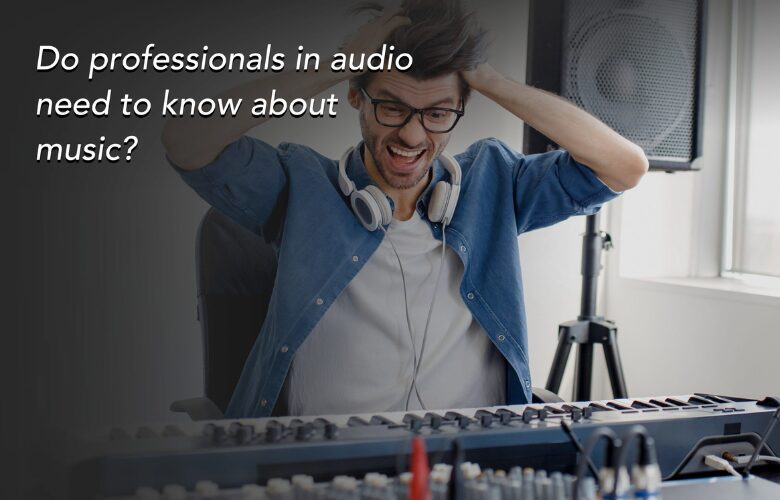
My straight answer will be no, some of the best sound engineers in the industry are not musicians. But if you want my advice as a musician and as a sound engineer, learning some basics about music won’t hurt you.
Being a sound engineer working on projects that involve music treatment such as, recording, editing, mixing, etc., will require you to have and develop some aptitudes and basic knowledge about music that will allow you to have a better performance at your job. This means, even if you are not a musician you will need to have a good ear for music: recognize pitch and tone, recognize which musical instruments are playing, recognize if musical instruments are out of tune, recognize harmonic patterns and form of a piece of music, recognize and follow beats and rhythmic patterns, be sensible to dynamics.
Let’s go deeper into each topic
The Click:
Every piece of music has a heartbeat called tempo that follows a metronome marking measured in beats per minute (bpm). If a music sheet is available, this metronome marking will be indicated at the top left of the music sheet. It could be indicated by numbers or by musical terms in Italian that give you a hint about the tempo. Most of the time, It will be necessary for recordings and/or live performances to set up the click on your DAW or music software. Depending on the musician’s request, the click can be set to follow the tempo or subdivided, make sure you are familiar with setting up a click on your software before you run your session.
Bars and time signatures:
Beats are grouped into bars, and they can vary depending on the music, bars can also change within the same piece of music. The number of beats on a bar can be 1, 2, 3, 4, 5, etc. Bars can also be set up in your software, it will appear as a number with two digits: one number at the top that indicates how many beats there are inside the bar, and the bottom number that will indicate the type of notes used inside the bar ( half, quarter, eight, etc.). Knowing the time signature will help you with bar counting and following rhythm patterns, it will also help you to locate specific parts in a piece of music. But it will also allow the musician to identify bar counts and pulses.
Strong beat:
Each bar has strong and weak beats that give music memorable rhythmic patterns. Usually, the first beat is the strong beat of the bar (known as downbeat), this feature can be set up on the software so bars can have different accents, levels, and sounds for each beat, helping musicians during their performance. Knowing all these settings when configuring the click and timeline of your session are essential.
Pickup:
Understanding the pickup term or anacrusis is handy when you need to anticipate music recordings or performances. If you hear this term, it will mean that the music will start with a note or a group of notes preceding the first downbeat. Its main characteristic is that the pickup is a partial bar before the first bar of the music starts.
Form:
The structure of a piece of music is known as musical form. Familiarizing yourself with the different types of forms can help you organize your session in an efficient way. You will find musical phrases, harmonic structures, chord progressions, modulations, and rhythmic patterns within the music that will help you when it comes to recognizing different forms. A good way to familiarize yourself with it is to hear and read about diverse styles of music so you can identify which form is present in the piece of music. For popular music, forms elements like chorus, and bridge can be more familiar to identify, however, for other types of music training your ear is the best way to go.
One terrific example of a very distinguished type of form is basic blues: Blues form is 12 bars and its chord progression are very distinctive because the I chord is a dominant chord as well as the IV chord and the musicians have taken the Basic I7-IV7-V chord to be used in it. Other forms like Binary (AB), Ternary (ABA) , Rondo (ABACA) or (ABACABA), Arch (ABCBA), Sonata (Exposition, Development, Recapitulation), Theme, And Variations can be studied so you can identify them better for your sessions.
Chord progression:
Most music written is based on scales and keys. Each note of a scale is identified as a grade. The sequence and order of the chords based on these grades of the scale is called a chord progression. The primary chords are I, IV, V, and some popular music genres have distinctive chord progressions that can be identified easily, like the progression I-IV-V-I used in most pop songs. Because of the variety of grades and scales that can be present in a song, chord progressions can help you identify the form of a song and the genre, recognize phrases and themes easily, and locate musical parts to help you get very creative.
Cadence:
As part of the chord progressions, the way a musical theme, phrase, or idea ends will be harmonically accompanied by at least two chords that are recognized as a cadence. This cadence gives a sense of resolution and can be classified into many types. One of the easiest to recognize will be the perfect cadence that goes from V chord to I chord where the bass note is the main note (tonic) of each chord. Being able to recognize cadences during large pieces of music can help you. With your creative process while mixing, etc.
A riff is a pattern of notes that are repeated throughout a piece of music. Riffs do not repeat immediately and are usually found at the end of the verse in a song or in the chorus.
Groove, a term borrowed from jazz musicians, often refers to a rhythmic sense of cohesion employed in a routine or musical practice style.
Solo is an improvisation section where each instrumentalist performs, the order can be predetermined, or not. Solos are performed in the form of the theme and the number of turns are called choruses.
Fill are improvised melodic or rhythmic phrases, played between phrases of the theme.
A vamp is a repeating musical figure, section, or accompaniment until the cue for the next section is given.
An interlude is a pre-written arrangement that serves as a transition between sections or solos.
Breaks are momentary interruption of musical discourse while time is maintained. Sometimes, a soloist could play during the break (solo break).
If you have never heard an instrument you are about to record, just ask the musician to explain to you how is it played and any other details you might be interested in knowing, ask the musician to play the instrument in front of you so you can hear it, walk around it and find the best place to place a microphone for recordings or amplifications.
Tunning:
Identifying instruments out of tune can be tricky and it takes a lot of training so the best way to proceed is to remind the musician before recordings and every once in a while during long sessions, to check their tuning every time possible.
Pitch is how the human ear understands the frequency at which a sound wave is being produced by any source. The higher the frequency the higher the pitch and vice versa. Musical instruments can produce different pitch ranges depending on its construction. Each musical note produced by any instrument has a related frequency measured in (Hz) that will then be interpreted as a specific pitch or note (c, d, e, f, g, etc.)
Many resources can be found online to help you train your ear and learn about musical instruments and music theory. If you are interested in going deeper into these concepts check out:
Learn about orchestration, listen to every musical instrument in an orchestra, their construction, pitch range, tips, tricks, and more :
https://andrewhugill.com/OrchestraManual/
Learn music theory:
https://www.musictheory.net/lessons
Improve core listening skills like frequency detection (Soundgym offers SoundGirls Members Subscriptions to the service):
https://www.soundgym.co/


The mission of SoundGirls.org is to inspire and empower the next generation of women in audio. Our mission is to create a supportive community for women in audio and music production, providing the tools, knowledge, and support to further their careers. SoundGirls.Org was formed in 2013 by veteran live sound engineers Karrie Keyes and Michelle Sabolchick Pettinato and operates under the Fiscal Sponsorship of The California Women’s Music Festival, a 501(c)3 non-profit organization. In 2012, Karrie and Michelle participated in the “Women of Professional Concert Sound” panel at the AES Conference in San Francisco. The panel was hosted by the Women’s Audio Mission (WAM) and moderated by WAM founder Terri Winston. Terri brought together five women working in live and broadcast audio. The groundbreaking panel (which also included Jeri Palumbo, Claudia Engelhart and Deanne Franklin), provided young women and men a glimpse into life on the road, tips and advice, and a Q & A with the panelists. More importantly though, was how incredibly powerful the experience was for the panelists. We had all been in the business for 20 years or more, yet most of us had never met before that day and within minutes we bonded like long-lost sisters. We were struck by how similar our experiences, work ethics, and passions were and wondered why our paths had never crossed and how our careers would have been different had we been there to support each other through the years. Each of us are strong on our own, but together we were even stronger and a powerful force. We were empowered. Each of us had been asked hundreds of times in our careers: Are there other women doing sound? How did you get into sound? How would a young woman go about getting into sound? Through creating SoundGirls.Org, we hope to establish a place for women working in professional audio to come for support and advice, to share our success and failures, our joys and frustrations, and for empowerment and inspiration.
Read Full Profile© 2021 TheatreArtLife. All rights reserved.

Thank you so much for reading, but you have now reached your free article limit for this month.
Our contributors are currently writing more articles for you to enjoy.
To keep reading, all you have to do is become a subscriber and then you can read unlimited articles anytime.
Your investment will help us continue to ignite connections across the globe in live entertainment and build this community for industry professionals.